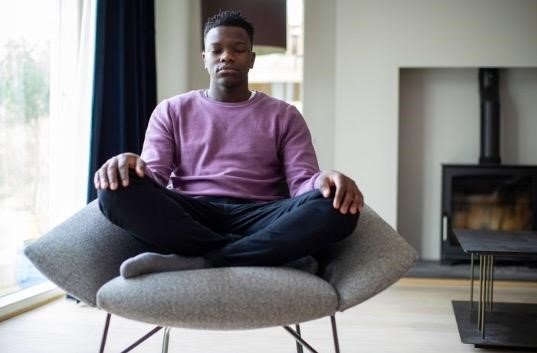Introduction
Have you ever experienced a chaotic morning where everything seems to go wrong? The alarm fails, coffee spills, and you can’t find your keys.
Stress takes over quickly. Imagine if there were a simple way to regain control and start each morning fresh. That’s where 5-minute meditation comes into play.
What is Meditation?
Meditation is a practice that involves focusing your mind and eliminating distractions to achieve mental clarity and emotional calm. It can take many forms, from mindfulness and breathing exercises to guided imagery and mantras.

The goal is to cultivate a state of awareness and inner peace, making it a valuable tool for stress reduction and overall well-being.
About 5-Minute Meditation
This short, impactful practice focuses on mindfulness and allows you to cultivate calmness and concentration quickly.
Despite its brevity, meditating for five minutes is a powerful addition to your routine. It’s suitable for everyone, from beginners to seasoned practitioners, and offers a practical way to incorporate mindfulness into your day.
Why only Five Minutes of Meditation? Why Not More?
Choosing five minutes strikes a balance between effectiveness and feasibility. It’s long enough to help clear your mind and set a positive tone for the day but short enough to fit into even the busiest schedules.
This duration makes it accessible, ensuring that meditation becomes a consistent habit without feeling overwhelming. Longer sessions can deepen practice, but starting with five minutes is an excellent way to establish a regular routine without barriers.
Benefits of 5 Minutes of Meditation Every Morning
Stress Reduction

Starting your day with meditation reduces anxiety, creating a sense of peace that extends throughout your day. Deep breathing calms the mind and lowers cortisol levels, helping you maintain composure under pressure. Focusing on mindfulness can transform your response to stress.
Increased Focus and Clarity
Regular meditation sharpens focus and enhances mental clarity. By centering your mind, you become more productive and efficient, tackling tasks with a clear perspective. This heightened sense of awareness allows you to breeze through your to-do list quickly.
Enhanced Mood and Well-being
Beginning your day with meditation uplifts your mood and boosts emotional health. This daily ritual fosters a positive mindset, leading to a more joyful outlook on life over time. It enhances self-awareness, encouraging a deeper connection with your thoughts and emotions.
Why Meditate in the Morning?
Meditating in the morning has unique benefits that can positively influence your entire day:
- Sets a Positive Tone: Starting your day with meditation helps set a calm and positive tone, preparing you mentally and emotionally for the challenges ahead.
- Boosts Focus and Productivity: Morning meditation clears your mind, enhancing your focus and productivity throughout the day.
- Promotes Consistency: Establishing a morning routine makes maintaining a consistent meditation practice easier.
However, meditation is flexible and can be practiced at any time of day. Here are the benefits of meditating at different times:
- Afternoon Meditation: This can serve as a mid-day reset, helping to reduce stress and recharge your energy levels, enhancing afternoon productivity.
- Evening Meditation: Meditating before bed can improve sleep quality by promoting relaxation and helping to clear your mind of the day’s stressors.
Ultimately, incorporating multiple meditation sessions throughout the day can provide even more significant benefits, offering continuous moments of calm and clarity.
How to Practice 5-Minute Meditation
Setting the Scene
Choose a quiet space where you won’t be disturbed. This could be a corner of your bedroom, a spot in your living room, or even a cozy nook in your garden.

Sit or lie down comfortably on the surface or furniture of your choice, keeping your spine straight to maintain alertness. Creating a comfortable, quiet, and relaxed environment is crucial for a successful meditation session.
Basic Meditation Techniques
Begin by closing your eyes and focusing on controling your breath. Inhale deeply through your nose, then allow your abdomen to expand, and exhale slowly from your mouth. Focus as much as possible on the sensation of your breath as it enters and leaves your nostrils.

If your thoughts wander, gently bring your awareness back to your breath without judgment. This practice helps you develop greater self-awareness and mental calm.
Watch this 5-minute guided meditation video to help you get started:
Guided vs. Unguided Meditation
When practicing 5-minute meditation, you can choose between guided or unguided sessions. Guided meditation involves following instructions from a teacher or app, providing structure and support, especially for beginners.
Unguided meditation allows for self-direction and can deepen your practice over time. Both approaches have unique benefits, so explore each to find what works best for you.
Tips for Making 5-Minute Meditation a Habit
Consistency is Key
Incorporating meditation into your daily routine requires consistency. Set a specific time for your meditation session each day, perhaps right after waking up or starting your workday.

Consider setting a reminder on your cellphone or using a meditation app to keep you on track. Make it a non-negotiable part of your daily routine, like brushing your teeth or drinking your morning coffee.
Overcoming Common Challenges in Meditation
Even with a short meditation practice, distractions are inevitable. It’s perfectly normal for your mind to wander, especially if you have ADHD or simply dislike meditating.
Here are some strategies to overcome these challenges and alternative mindfulness practices for those who struggle with traditional meditation.
Challenges and Solutions
For People with ADHD or Short Attention Spans
- Challenge: Staying focused during meditation can be particularly difficult for individuals with ADHD due to their tendency for rapid and persistent thought patterns.

- Solution: Break the meditation into even shorter segments. Start with just one minute and then gradually increase the duration. Using guided meditation apps that provide structure and prompts can also be helpful.
If You Dislike Meditating
- Challenge: Some people find meditation tedious or frustrating.
- Solution: Experiment with different types of meditation to find what resonates with you. Guided meditations, music, or movement-based practices like yoga or tai chi can make meditation more engaging.
For info on maintaining high testosterone levels, read our guide on 5 Best Lifestyle Hacks for Higher Testosterone.
Alternative Mindfulness Practices
Micro Mindfulness
- Eating Mindfully: Focus entirely on your meal without distractions from TV or electronics. Pay attention to the taste, texture, and even the aroma of your food.
- Mindful Walking: Take a walk without your phone. Observe your surroundings, the sensation of your feet on the ground, and your breathing.
- Grocery Shopping: Turn off your phone while shopping and concentrate on the experience. Notice the colors, shapes, and smells of your chosen items.

Breathing Exercises
- Deep Breathing: Practice deep breathing exercises, such as inhaling deeply through your nose, holding for a few seconds, and exhaling slowly through your mouth. This can be done anywhere and helps calm the mind.

- Box Breathing: Inhale for four counts, hold for four counts, exhale for four counts, and then hold again for four counts. Repeat this cycle continuously several times to promote relaxation and focus.
Incorporating Mindfulness into Daily Activities
Integrate mindfulness into routine activities to make it more natural and less daunting:
- Mindful Cleaning: Focus on what needs to be cleaned and how you perform the task;, the motion of your hands, and the results of your efforts.
- Driving: Turn off the radio and be present while driving. Notice the road, the scenery, and your breathing.
For info on maintaining staying motivated and consistent with your workouts, check out Low Gym Motivation? 7 Strategies to Conquer Workout Excuses & Hit Your Fitness Goals
Overcoming challenges in meditation requires patience and flexibility. Adapting your approach can help if you have ADHD, dislike meditating, or face other distractions.
Incorporate micro mindfulness practices and breathing exercises into your daily routine to cultivate mindfulness without feeling overwhelmed.
Remember, the goal is to find what works best for you and make it a consistent part of your life.
Additional Resources for Meditation Practice

Recommended Apps and Tools
Consider using apps like Headspace, Calm, or Insight Timer to support your meditation practice. These apps offer a variety of guided meditations, music tracks, and talks that can help you stay consistent and motivated.
Each provides unique features tailored to different needs, making them valuable resources for beginners and experienced meditators.
Further Reading and Courses
If you’re interested in delving deeper into mindfulness, explore books such as “The Miracle of Mindfulness“ by Thich Nhat Hanh and “10% Happier” by Dan Harris. These books offer insights into mindfulness practice and its impact on daily life.
Online courses, such as Mindfulness-Based Stress Reduction (MBSR) or Yale’s The Science of Well-Being on Coursera, provide comprehensive introductions to mindfulness meditation and its benefits.
Conclusion
Incorporating 5-minutes of meditation into your morning routine can be transformative. This short yet impactful practice helps reduce stress, improve focus, and enhance mood.
Dedicating just a few minutes each day to meditation cultivates greater awareness and reaps significant mental and emotional benefits.
If you’ve never tried meditation, now is the perfect time. Remember, the best way to start is simply to begin. Just five minutes could be the gateway to a more mindful, focused, and happier you.
Give it a try, and let’s embark on this journey towards wellness together. Thank you for reading. May your mornings be serene and your days filled with clarity and purpose.
FAQ on 5-Minute Meditation
1. How do I find a comfortable position for meditation?
To find a comfortable position for meditation, sit in a quiet space where you won’t be disturbed. Sit with your spine straight to maintain good posture, either on a cushion or a chair with your feet flat on the ground. Rest your hands on your lap. This setup helps you stay alert and focused while promoting a sense of calm and relaxation.
2. What are the benefits of meditation, especially for just a few minutes a day?
Practicing meditation for even a few minutes daily can lead to numerous benefits, including reduced anxiety, improved sleep quality, and enhanced productivity.
Regular meditation can also help lower stress levels, improve resilience, and promote greater well-being. Over time, this practice can improve one’s ability to handle challenges with a calm and focused mind.
3. How can I bring my attention to the present moment during meditation?
To bring your attention to the present moment, start by taking a deep breath and then focusing on the sensation of your breath as it enters and then leaves your nostrils. You can also perform a body scan, mentally noting any sensations or tingles you feel in different parts of your body.
If your mind starts to wander, gently bring your awareness back to your breath or the present moment without judgment.
4. Can walking meditation be an alternative to sitting meditation?
Yes, walking meditation can be a great alternative if you find it challenging to sit still. In walking meditation, you focus on the sensation of each step, the movement of your legs, and your breath.
This practice helps you stay mindful and present, offering similar benefits to sitting meditation, such as reduced stress and enhanced mental clarity.
5. What should I do if I get frustrated or anxious during meditation?
It’s normal to feel frustrated or anxious when you start meditating. If this happens, take a few deep breaths to help calm your mind and body. Try focusing on a specific point, like the rise and fall of your abdomen, or a visualization technique, such as imagining a golden light.
If you continue to struggle, consider switching to a guided meditation session led by a renowned meditation teacher to help you stay focused.
6. How can meditation improve my sleep quality and help with insomnia?
Meditation can improve sleep quality by promoting a relaxed state of mind, reducing anxious thoughts, and lowering stress levels. Practices such as body scans and deep breathing exercises before bed can help prepare your mind and body for sleep.
Regular meditation can also help alleviate insomnia by establishing a routine that signals to your body that it’s time to unwind and prepare for rest.
7. What is transcendental meditation, and how is it different from other forms of meditation?
Transcendental Meditation is a form of meditation in which one silently repeats a mantra for 15-20 minutes twice daily.
Unlike mindfulness or body scan meditations, which focus on the present moment or physical sensations, TM aims to transcend ordinary thinking and reach a state of pure awareness. Certified meditation teachers often teach this ancient practice.
8. If I dislike traditional meditation practices, Can I integrate meditation into my daily routine?
Absolutely! If traditional meditation doesn’t appeal to you, try micro-mindfulness practices. These include eating a meal without distractions like TV or electronics, going for a walk without your phone, or focusing on your breathing while grocery shopping.
These activities help you stay present and mindful, offering similar benefits to traditional meditation.
9. How can I express gratitude during my meditation practice?
Expressing gratitude during meditation can enhance your sense of well-being and positivity. Begin your session by taking deep breaths and bringing your attention to the present moment.
Then, think of three things you are grateful for and focus on the feelings of gratitude. This practice can help shift your outlook on life and your mindset and improve your overall mood.
10. How long does it take to see the benefits of meditation?
Meditation’s benefits can be noticed quickly, often within a few weeks of regular practice. Studies suggest that eight weeks of consistent meditation practice can significantly improve mental and physical health, including stress reduction, enhanced focus, and a greater sense of calm. However, even a single session can provide immediate relief from stress and anxiety.









